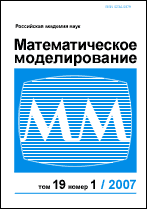|
This article is cited in 1 scientific paper (total in 1 paper)
Numerical solving unsteady problems for the system of the Nernst–Planck equations
P. N. Vabishchevichab, O. P. Ilievab
a Nuclear Safety Institute RAS, Moscow, Russia
b Fraunhofer Institute for Industrial Mathematics, Kaiserslautern, Germany
Abstract:
The mathematical model of electricity and mass transfer processes is based on the governing equations for the concentration of charged particles (ions and cations) in an electrolyte — the Nernst–Planck equations. These equations are supplemented with the equation for the electric field and the equations for a motion of electrolyte as a continuum medium. In this work we have focused on constructing approximations in time for approximate solving unsteady problems. The system of the Nernst-Planck equations is characterized by a quadratic non-linearity. To take info accont this nonlinearity, we propose special schemes of linearization. Computational algorithms are studied using a model problem for a binary electrolyte (two types of charged particles).
Keywords:
electricity and mass transfer, the Nernst–Planck equations, difference scheme, quadratic non-inearity.
Received: 13.10.2011
Citation:
P. N. Vabishchevich, O. P. Iliev, “Numerical solving unsteady problems for the system of the Nernst–Planck equations”, Matem. Mod., 24:10 (2012), 133–148; Math. Models Comput. Simul., 5:3 (2013), 229–243
Linking options:
https://www.mathnet.ru/eng/mm3326 https://www.mathnet.ru/eng/mm/v24/i10/p133
|

|




 Contact us:
Contact us: Terms of Use
Terms of Use
 Registration to the website
Registration to the website Logotypes
Logotypes







 Citation in format
Citation in format 
